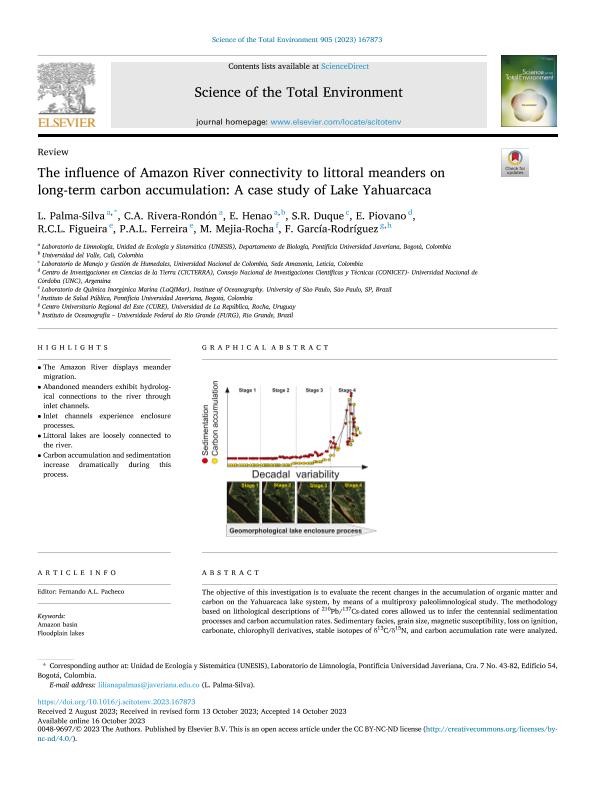Artículo
The influence of Amazon River connectivity to littoral meanders on long-term carbon accumulation: A case study of Lake Yahuarcaca
Palma Silva, L.; Rivera Rondón, C.A.; Henao, E.; Duque, S.R.; Piovano, Eduardo Luis ; Figueira, R.C.L.; Ferreira, P.A.L.; Mejia Rocha, M.; García Rodríguez, F.
; Figueira, R.C.L.; Ferreira, P.A.L.; Mejia Rocha, M.; García Rodríguez, F.
 ; Figueira, R.C.L.; Ferreira, P.A.L.; Mejia Rocha, M.; García Rodríguez, F.
; Figueira, R.C.L.; Ferreira, P.A.L.; Mejia Rocha, M.; García Rodríguez, F.
Fecha de publicación:
12/2023
Editorial:
Elsevier
Revista:
Science of the Total Environment
ISSN:
0048-9697
e-ISSN:
1879-1026
Idioma:
Inglés
Tipo de recurso:
Artículo publicado
Clasificación temática:
Resumen
The objective of this investigation is to evaluate the recent changes in the accumulation of organic matter and carbon on the Yahuarcaca lake system, by means of a multiproxy paleolimnological study. The methodology based on lithological descriptions of 210Pb/137Cs-dated cores allowed us to infer the centennial sedimentation processes and carbon accumulation rates. Sedimentary facies, grain size, magnetic susceptibility, loss on ignition, carbonate, chlorophyll derivatives, stable isotopes of δ13C/δ15N, and carbon accumulation rate were analyzed. LANDSAT and photographic record of satellite images were used to reconstruct the historical geomorphological evolution of the Lake. Sediment cores yielded basal ages of 1827 and 1828 Common Era, representing the formation of lakes as a consequence of the Amazon meandering process. Two main paleolimnological stages were identified, with a boundary transition set at 1980?1984 Common Era, attributed to the geomorphological closure and complete lake separation from the Amazon and the onset of full lentic conditions. This inference was mainly based on both sharp increases in the sedimentation rate from 0.2 to >1 cm yr−1 and carbon accumulation that increased seven-fold (from 2 to 14 g m-2 yr−1) from 1980 to 1984 Common Era. The flood-pulse and connection to the Amazon defined the magnitude of organic inputs, where areas more distant/isolated from the river showed higher accumulation of carbon from autochthonous production, with an average of 8.9 % and 1.10 g m−2 yr−1 (carbon accumulation rate). Those areas closer and connected to the river were strongly related to the interannual hydrological variability, with a lower mean carbon content (5.9 %) and 0.73 g m−2 yr−1 (carbon accumulation rate). We concluded that carbon burial was highest within the most distant spot from the Amazon River because of the weaker connection to the river itself and the more stable lentic conditions for net sedimentation.
Palabras clave:
AMAZON BASIN
,
FLOODPLAIN LAKES
,
PALEOLIMNOLOGY
,
RIVER FLOODING
Archivos asociados
Licencia
Identificadores
Colecciones
Articulos(CICTERRA)
Articulos de CENTRO DE INVEST.EN CS.DE LA TIERRA
Articulos de CENTRO DE INVEST.EN CS.DE LA TIERRA
Citación
Palma Silva, L.; Rivera Rondón, C.A.; Henao, E.; Duque, S.R.; Piovano, Eduardo Luis; et al.; The influence of Amazon River connectivity to littoral meanders on long-term carbon accumulation: A case study of Lake Yahuarcaca; Elsevier; Science of the Total Environment; 905; 167873; 12-2023; 1-14
Compartir
Altmétricas



